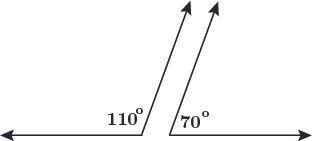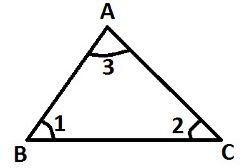About Lesson
अध्याय 4: सरल समीकरण Class 7 Math
Line, line segment and ray
- If we take a point and draw a straight path that extends endlessly on both the sides, then the straight path is called as a line.
- A ray is a part of a line with one endpoint.
- A line segment is a part of a line with two endpoints.

Angles
- An angle is formed when two rays originate from the same end point.
- The rays making an angle are called the arms of the angle.
- The end point is called the vertex of the angle.

Complementary Angles
- Two angles whose sum is 900 are called complementary angles.
Example: 500 + 400 = 900
∴ 500 and 400 angles are complementary angles.

Parallel Lines and a Transversal
Transversal intersecting two lines
- Transversal is a line that intersects two or more lines at different points.

- Corresponding Angles:
(i) ∠1 and ∠5 (ii) ∠2 and ∠6
(iii) ∠3 and ∠7 (iv) ∠4 and ∠8 - Alternate Interior Angles:
(i) ∠3 and ∠6 (ii) ∠4 and ∠5 - Alternate Exterior Angles:
(i) ∠1 and ∠8 (ii) ∠2 and ∠7 - Interior angles on the same side of the transversal:
(i) ∠3 and ∠5 (ii) ∠4 and ∠6
Transversal of Parallel Lines

- If a transversal intersects two parallel lines, then each pair of corresponding angles is equal.
(i) ∠1=∠5 (ii) ∠2=∠6
(iii) ∠3=∠7 (iv) ∠4=∠8 - If a transversal intersects two parallel lines, then each pair of alternate interior angles is equal.
(i) ∠3=∠6 (ii) ∠4=∠5 - If a transversal intersects two parallel lines, then each pair of interior angles on the same side of the transversal is supplementary.
(i) ∠3+∠5=1800 (ii) ∠4+∠6=1800
Checking if two or more lines are parallel
- There are three conditions to check whether the two lines are parallel. They are:
(i) If a transversal intersects two lines such that a pair of corresponding angles is equal, then the two lines are parallel to each other.
(ii) If a transversal intersects two lines such that a pair of alternate interior angles is equal, then the two lines are parallel.
(iii) If a transversal intersects two lines such that a pair of interior angles on the same side of the transversal is supplementary, then the two lines are parallel.
Intersecting Lines and Pairs of Angles
Supplementary angles
- Two angles whose sum is 1800 are called supplementary angles.
Example: 1100+700=900
∴ 1100 and 700 angles are supplementary angles.

Adjacent Angles
- Two angles are adjacent, if they have
(i) A common vertex
(ii) A common arm
(iii) Their non-common arms on different sides of the common arm.

- Here ∠ABD and ∠DBC are adjacent angles.
Linear Pair
- Linear pair of angles are adjacent angles whose sum is equal to 180∘.

- Here, 1 and 2 are linear pair of angles.
Vertically Opposite Angles
- Vertically opposite angles are formed when two straight lines intersect each other at a common point.
- Vertically opposite angles are equal.

Here, the following pairs of angles are vertically opposite angles.
(i) a and c
(ii) b and d
Intersecting and Non-Intersecting lines
- Intersecting lines are lines which intersect at a common point called the point of intersection.

Parallel lines are lines which do not intersect at any point. Parallel lines are also known as non- intersecting lines.

Basic Properties of a Triangle
Sum of Interior Angles in a Triangle
- Angle sum property of a triangle: Sum of all interior angles of a triangle is 1800.

- In △ABC, ∠1+∠2+∠3=1800
The exterior angle of a triangle = Sum of opposite internal angles
- If a side of a triangle is produced, then the exterior angle so formed is equal to the sum of the two interior opposite angles.

In △ABC, ∠CAB+∠ABC=∠ACD.
Join the conversation